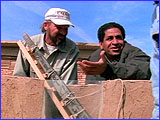
|
 |
 |
Hamada Rashwan, Engineer and Quarry Owner NOVA: How long have you been in the quarrying business? Rashwan: Let me see, it's been 29 years! NOVA: So you're quite used to moving large stones. Rashwan: We regularly move blocks of several hundred tons. First we remove the biggest stones from the quarry face, then we cut them down to size. We produced the obelisk that now stands at our embassy in Vienna. It's about 14 meters (46 feet) and weighs about 40 tons. And we now have a project to produce a fine-grained granite obelisk in the Sharma area, about 230 kilometers (142 miles) southeast of Aswan. We hope to go to 50 meters (165 feet) in length by five meters (16.5 feet) wide at the base, so the weight will probably be more than 2,000 tons. We chose 50 meters, because as you know the biggest ancient Egyptian obeliks is, I think, 46 meters (151 feet). It's no problem to produce it; the problem is how to raise it. We're now studying how the ancient Egyptians raised their obelisks. NOVA: Do you feel you've learned a lot about quarrying from the ancient Egyptians? Rashwan: Yes, of course, because as you know, all the ancient Egyptian obelisks were produced in this area, the Unfinished Obelisk area. I don't think the ancient Egyptians used people, the workers, to raise obelisks. They used very advanced engineering techniques. I think that is the true way. NOVA: Do you feel a spiritual link with the early Egyptian quarrymen? Rashwan: To be honest with you, we owe about 60 or 70 percent of our knowledge on splitting granite from the ancient Egyptians. They were very advanced in splitting granite, which was needed to get good stone for obelisks and other monumental architecture. NOVA: What do you think of this attempt to raise the obelisk? Rashwan: This is not a real obelisk! This is an obelisk project, which is studying the techniques, but the obelisk itself is very small compared to those produced by the ancient Egyptians. You'll remember that the largest they produced was 450 tons; this one is about 30 to 35 tons. And the way you'll raise it when it is inclined from the vertical by only about eight degrees—you can do this with five or ten persons! In my opinion, this does not give us a clear idea of the ancient Egyptian method. We need 100 or 200 tons to see how the Egyptians did it; not 30 tons only, and not only eight degrees from the vertical. You need more. NOVA: So, if you were in charge, you would use a 100-ton obelisk? Rashwan: A 100-ton obelisk, brought from the quarry along a tunnel and right to the place of raising. Because, in my opinion, the ancient Egyptians transported each obelisk by a tunnel from the face of the quarry to the Nile, put it on a ship, and shipped it to the place they wanted. In my opinion, there is no other way to remove a block of a few hundred tons. It would have been very easy for the ancient Egyptians to make a tunnel that extended the few hundred meters from the quarries to the river. NOVA: Do you think you could get the Unfinished Obelisk out if you were asked to do so? Rashwan: Yes, of course. By advanced engineering techniques, as you saw in the last film, it's really easy to do. It's not difficult. NOVA: Even though it weighs over 1,100 tons? Rashwan: No problem, because you can reduce the weight according to an engineering system for raising. I'm sure the ancient Egyptians used this way. NOVA: Are you impressed then by what they could do? Rashwan: Yes, we continue to learn from the mountain. For example, when we prepare our quarry faces for successful production, with good quality and good splitting, we follow the ancient Egyptians. If you look at our faces here, you'll see that they run in the same east-west direction as the Unfinished Obelisk, because this is the best way to split granite. NOVA: What do your workers think of this project? Rashwan: They have more than 20 years experience, and for them, this is a simple job. NOVA: What did they say about our attempt to move a 25-ton block with 200 people (see Pulling Together)? Rashwan: They told me, "We can move it with five people, with wood rollers." And they plan to give it a try! Explore Ancient Egypt | Raising the Obelisk | Meet the Team Dispatches | Pyramids | E-Mail | Resources Classroom Resources | Site Map | Mysteries of the Nile Home Editor's Picks | Previous Sites | Join Us/E-mail | TV/Web Schedule About NOVA | Teachers | Site Map | Shop | Jobs | Search | To print PBS Online | NOVA Online | WGBH © | Updated November 2000 |
 Hamada Rashwan (r)
Hamada Rashwan (r)